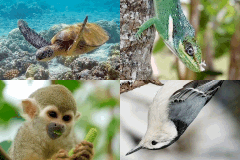AnAge entry for Plantae
Classification (HAGRID: 04240)
- Taxonomy
- Kingdom
- Plantae (Browse taxon)
- Common name
- Plants
- Synonyms
- Temp dummy name, Uncertain LC family
- Find members of Plantae
- Find members of Plantae
Lifespan, ageing, and relevant traits
- Observations
The huge diversity of ageing phenotypes observed in plants is impossible to capture herein. Some plants are semelparous, degenerating quickly after reproduction while others can live over 1,000 years [0002]. It has been reported that some species of large trees capable of living for millennia endure age-related losses in function that are a result of their excessive size, not some intrinsic ageing process [0799].
The extreme longevity of some plants and the occurrence of vegetative reproduction make it difficult to accurately estimate longevity in these organisms. Although there are anecdotal claims of organisms living over 10,000 years, the oldest plant is probably the bristlecone pine (Pinus longaeva) that has been estimated to be able to live over 4,000 years and avoid ageing [0501].In trees mass growth rate increases continuously with tree size. Old trees act as senescent carbon reservoirs and actively fix large amounts of carbon compared to smaller trees [1288]. Species with vegetative reproductive may live even longer. Most notably, it has been estimated that the Kings Lomatia, Lomatia tasmanica, is sterile but has been propagating vegetatively for over 40,000 years [0850].
References
- [1271] Dahlgren et al. (2016), Actuarial senescence in a long-lived orchid challenges our current understanding of ageing (PubMed)
- [1230] Salguero-Gomez et al. (2016), Fast-slow continuum and reproductive strategies structure plant life-history variation worldwide (PubMed)
- [1288] Stephenson et al. (2014), Rate of tree carbon accumulation increases continuously with tree size (PubMed)
- [0799] Mencuccini et al. (2005), Size-mediated ageing reduces vigour in trees
- [0501] Lanner and Connor (2001), Does bristlecone pine senesce? (PubMed)
- [0850] Lynch et al. (1998), Genetic evidence that Lomatia tasmanica (Proteaceae) is an ancient clone
- [0002] Caleb Finch (1990), Longevity, Senescence, and the Genome
- [0452] Larry Nooden and A. Leopold (1988), Senescence and Aging in Plants
External Resources
- Integrated Taxonomic Information System
- ITIS 202422
- Animal Diversity Web
- ADW account (if available)
- Encyclopaedia of Life
- Search EOL
- NCBI Taxonomy
- Entrez
- Search all databases
- Ageing Literature
- Search Google Scholar or Search PubMed
- Images
- Google Image search
- Internet
- Search Google

